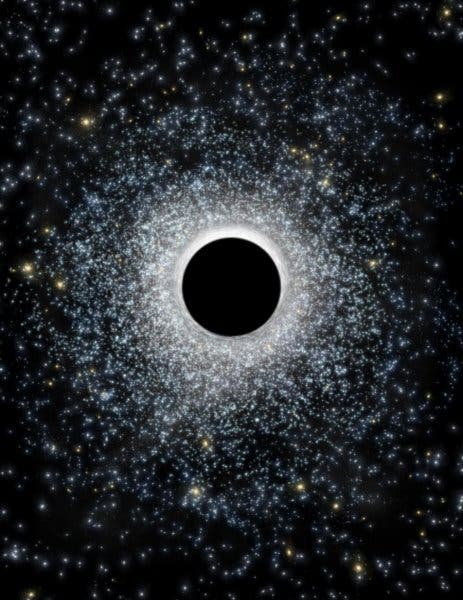Generally speaking, black holes fall into two categories: small, with a mass comparable to that of the Sun, or supermassive, weighing millions or even billions of Suns. Researchers have postulated that middleweight black holes should also exist but were unable to actually find one — until now.

Credit: CfA / M. Weiss
When most black holes are discovered, astronomers see X-rays coming from a hot disk of material swirling around it, but this only works if the black hole is actively feeding on nearby gas. Supermassive black holes can also identified by the gravitational effect they have on nearby stars, but that also only works in a limited number of cases. There’s a good chance that many black holes don’t respect either of these criteria and there may be a swarm of them lying undiscovered in our galaxy. Harvard astronomers have been on the lookout for such intermediate-sized black holes.
“We want to find intermediate-mass black holes because they are the missing link between stellar-mass and supermassive black holes. They may be the primordial seeds that grew into the monsters we see in the centers of galaxies today,” says lead author Bulent Kiziltan of the Harvard-Smithsonian Center for Astrophysics (CfA).
They focused on a globular cluster called 47 Tucanae, located in the constellation Tucana, about 16,700 light years away from Earth, and 120 light years across. It can even be seen with the naked eye as it contains thousands of stars, as well as about two dozen pulsars. It’s not the first time 47 Tucanae has been investigated in the hope of finding a black hole at its center, but previous attempts have not been successful. Now, two pieces of evidence indicate the existence of such a black hole.
The first clue is the overall motion of the stars throughout the cluster. The globular cluster is so dense with stars that the big ones fall towards the center while the other ones spin around. The extra gravity from the black hole acts like a spoon “stirring the pot” of stars — causing them to slingshot faster and over greater distances. This change, even though subtle, is measurable. The second line of evidence comes from the pulsars mentioned above.
Pulsars are highly magnetized, rotating neutron stars or white dwarfs. The radio signals these pulsars emit are very recognizable and easy to detect by astronomers. These objects are also flung by the black hole’s gravity and are much farther from the center of the cluster than you’d expect.
So although we can’t see the black hole directly, we get a good glimpse of its gravity effect. Kiziltan believes the black hole has a mass of about 2,200 solar masses, which would make it a perfectly fit for the middleweight category they were looking for. The team now wants to look in similar clusters, to see if a similar analysis could reveal other hidden black holes.
Journal Reference: Bülent Kızıltan, Holger Baumgardt, Abraham Loeb. An intermediate-mass black hole in the centre of the globular cluster 47 Tucanae. Nature, 2017; 542 (7640): 203 DOI: 10.1038/nature21361






